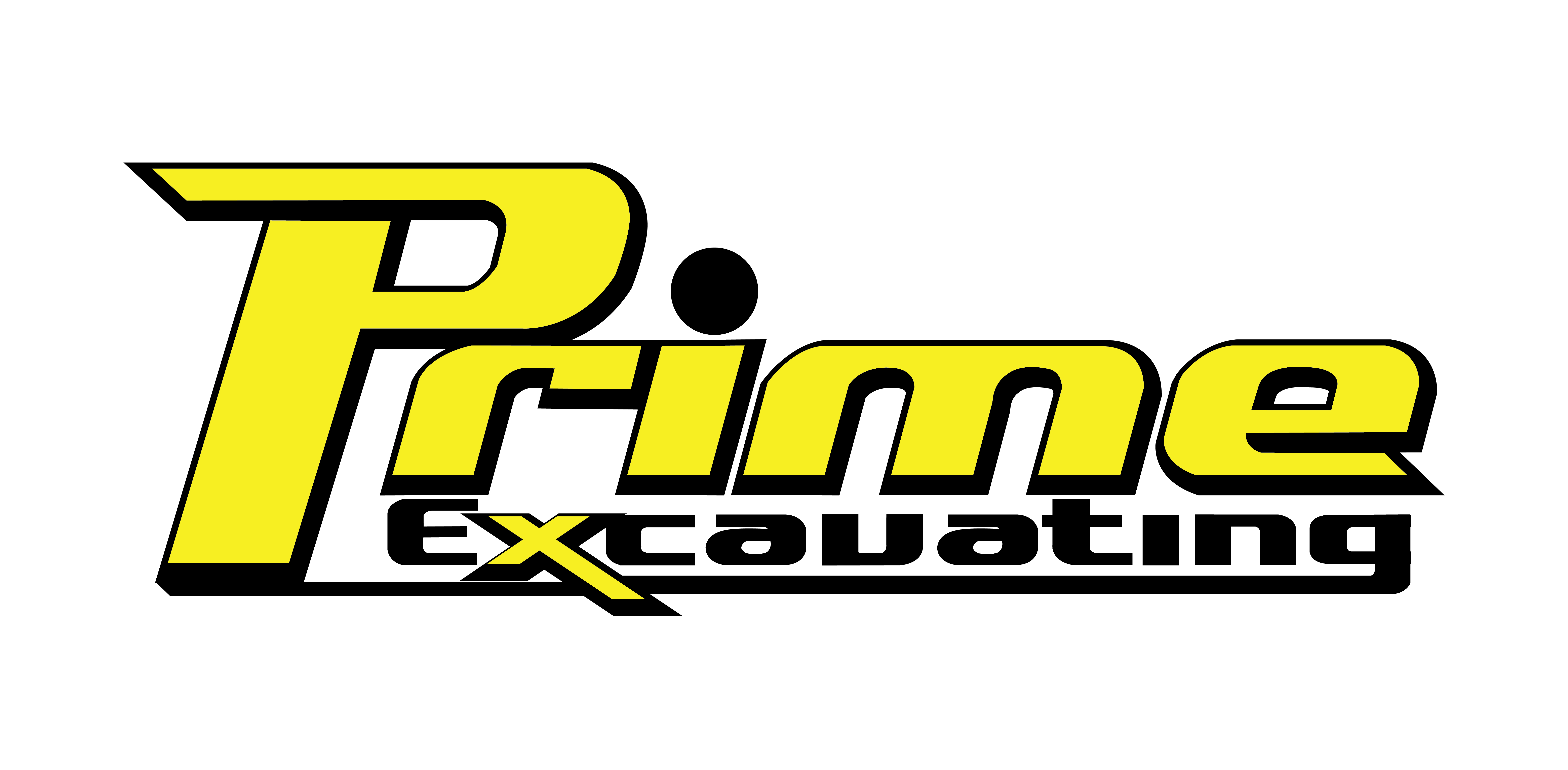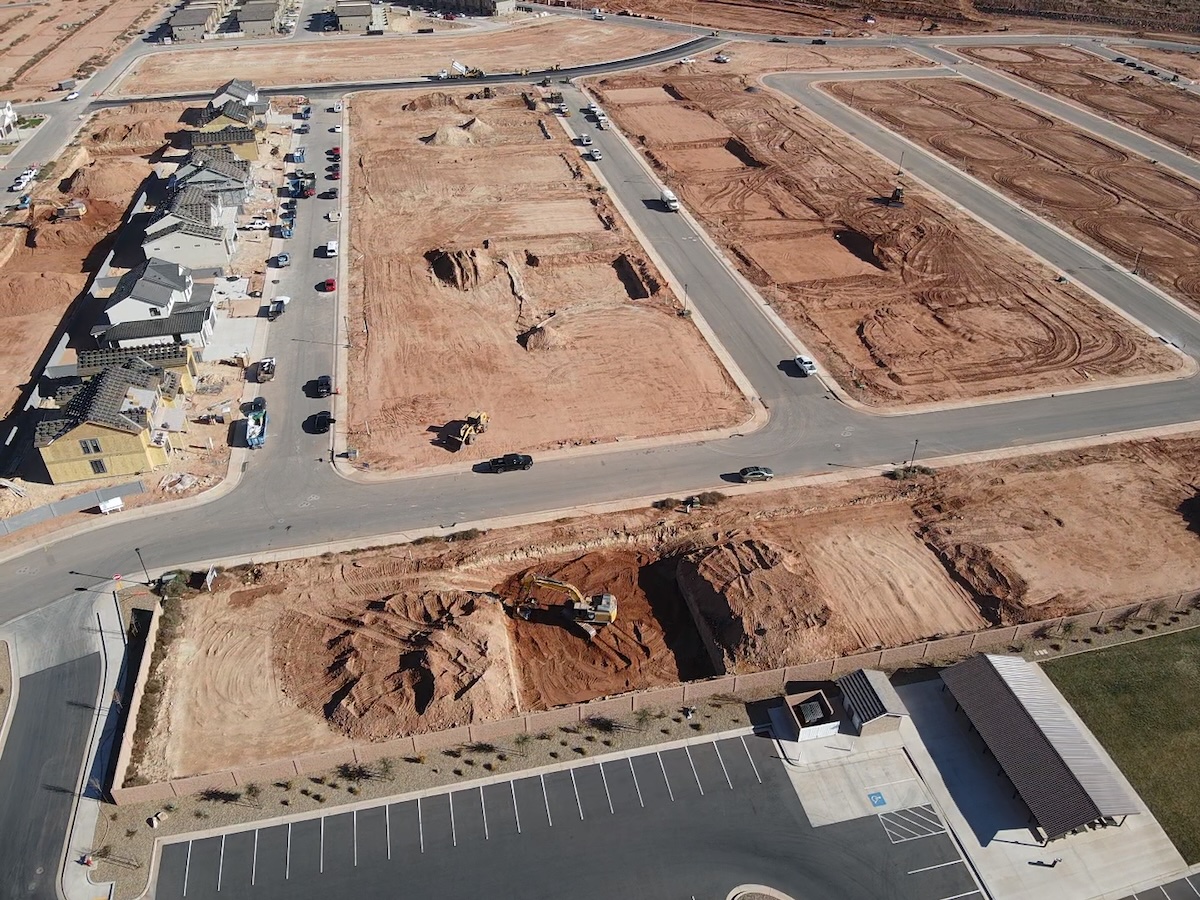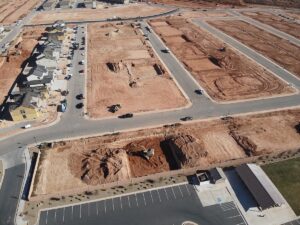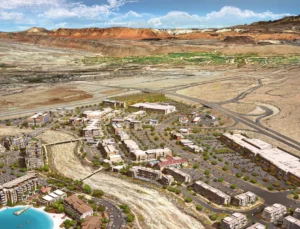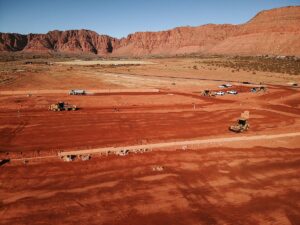Residential excavation techniques are the foundation of every successful housing development in Southern Utah. From Cedar City to St. George, choosing the right excavation strategy is critical for long-term structural safety, drainage, and code compliance.
Before roads, foundations, or utilities can take shape, expert excavation is the first and most critical step, laying the groundwork for a compliant, long-lasting development.
Southern Utah’s varied terrain, from red rock plateaus to loose sand and gravel, requires excavation strategies tailored to site conditions. Without it, developments risk unstable subgrades, water management failures, or non-compliance with local building codes.
With nearly 20 years of experience working on residential community developments, Prime Excavating partners with builders and land developers to deliver site-specific excavation solutions that meet regional requirements and development timelines.
This in-depth guide covers the top 5 residential excavation techniques tailored for Southern Utah, explains how to select the right method, compares common equipment, details compliance essentials, and closes with an FAQ to answer common questions asked by contractors and site developers in Southern Utah.
Table of Contents
- Importance of Choosing the Right Residential Excavation Techniques
- Trenching for Utilities
- Grading and Sloping
- Basement Excavation
- Over-Excavation and Backfill
- Rock Excavation
- Equipment Comparison
- Safety & Compliance
- FAQs
Importance of Choosing the Right Residential Excavation Techniques
Soil Compatibility
Southern Utah isn’t just “desert”—it includes:
- Clay-rich valleys near riverbeds: Swell after rain, need careful grading and drainage.
- Loose sand and gravel zones: Prone to collapse, require extra slope protection and compaction.
- Rocky or bedrock terrain: Common in canyons and foothills, might require rock breaking or blasting.
Learn more about local soil profiles at the Utah Geological Survey.
Foundation Safety
Every excavation is about much more than moving dirt; it’s about creating a stable, dry, and level base for your home. Poor excavation risks:
- Foundation cracks or settlement
- Water intrusion/basement leaks
- Utility line damage or regulatory fines
Smart contractors always begin with soil testing and adapt their method to the development’s site conditions and engineered specifications.
Technique 1: Trenching for Utilities
The backbone of any functional residential development is underground utility infrastructure —water, sewer, gas, and electric lines—reliant on precise trenching.
Types of Trenchers & Techniques
Types of Equipment & Techniques
- Mini-excavators: For tight spaces near existing structures.
- Back-hoe Excavators: Versatile for trenching and earth moving
- Full-size excavator: For large excavation and trenching
Trench depth standards (per ASCE & local code):
- Water: Typically 24–36 inches deep in Southern Utah.
- Sewer: Typically 4-10 feet deep in Southern Utah.
- Power: Typically 24-40 inches deep
- Gas: Typically 24-36 inches deep
- Communication/Phone/Fiber/Cable: Typically 24-48 inches deep
Key local requirement: Trenches are sloped (graded) to prevent water pooling and freezing; shoring/safety barriers are mandatory for deeper trenches.
Tip: For more details on grading, visit our Proper Site Grading for New Constructions blog, which explains why it’s essential for long-term foundation safety.
Technique 2: Grading and Sloping
Proper grading ensures water flows safely away from buildings and prevents soil erosion—a must in an area where flash floods can strike even in low-rainfall years.
How It Works
- Minimum 5% slope (6 inches in the first 10 feet from foundation) to direct water away.
- Laser-guided equipment for precise control.
- Drainage design tailored to each project site’s topography and drainage plan.
Local tip: Poor grading is a top cause of foundation trouble in St. George and Cedar City homes.
See our blog for more insights: Importance of Proper Site Grading for New Constructions.
Technique 3: Basement Excavation
Many new communities in Southern Utah incorporate full-basement homes into their site plans. Proper excavation for basement foundations at scale requires geotechnical awareness, safety coordination, and optimized logistics.
Step-by-Step Approach
- Site clearing and vegetation removal.
- Mark property lines (using GPS/laser tools).
- Staged digging, with temporary shoring as needed.
- Material is loaded into dump trucks/skid steers for removal.
- Post-excavation waterproofing: vital in clay-heavy soils.
Learn about our process for Basement Excavations.
Technique 4: Over-Excavation and Backfill
Some sites have expansive, soft, or otherwise unsuitable native soils.
Process
- Over-excavation: Removal of several feet below design level.
- Backfill: Engineered, compacted material or gravel replaces unfit soils in layers (“lifts”), tested for density and compaction.
- Geotechnical analysis ensures your foundation will last.
More info: Over-Excavation Services.
Technique 5: Rock Excavation
Bedrock and boulders are a fact of life—especially on hillside or canyon-side lots.
Blasting vs. Mechanical Breaking
- Mechanical: Hydraulic breakers/rock hammers break small/medium rocks; ideal when blasting isn’t practical or needed.
- Blasting: For mass rock, always completed by certified professionals (like Prime Excavating), following strict safety and local regulations.
Safety and Compliance Considerations
- Blue Stakes line location is mandatory statewide.
- All excavation follows OSHA, EPA, and local building codes.
- Stormwater management and dust/erosion controls protect your neighborhood and the environment.
Learn more about our fleet and safety commitments on our About Page.
Equipment Used: Comparison Table
| Equipment | Best For | Pros | Cons |
| Mini-Excavator | Tight spaces, trenching | Compact, efficient | Limited depth & bucket size |
| Full-Size Excavator | Basements, major grading | Power, reach | Needs large access area |
| Skid Steer Loader | Grading, backfill | Maneuverable | Not for deep digging |
| Dump Truck | Soil/rock hauling | High capacity | Needs room for turning |
For more on hauling, see Hauling Services.
Major Factors That Affect Excavation Technique
- Terrain: Hilly/rocky needs blasting or staged dig; flat/flood zones prioritize drainage.
- Budget: Method and equipment choice affects total cost—smart planning saves money long-term.
- Timeline: Over-excavation, rock removal, or permitting for blasting can extend your schedule.
Utah Soil Profile & Rainfall Impact
- Soil types: From river clays to mesa sand; consult Utah Geological Survey maps before you dig.
- Rainfall: 10–13 inches per year—mostly as monsoonal storms, which can cause flash flooding and trench erosion if grading/drainage aren’t handled professionally.
FAQs About Residential Excavation Techniques in Southern Utah
1. What’s the safest excavation method for residential development sites in Southern Utah?
The best method depends on local soil and terrain. For most residential projects, trenching with grading is safest and most common. Rocky or steep development sites may require staged mechanical excavation or blasting.
2. How do I know if a development site needs over-excavation?
If a geotechnical report reveals expansive, collapsible, or unstable soils, over-excavation and engineered backfill are necessary to ensure long-term structural integrity.
3. Is blasting for rock removal safe and legal here?
Yes—with licensed, permitted professionals. Prime Excavating meets all state/local safety and regulatory requirements.
4. Does excavation require permits in Southern Utah cities?
Yes. Permits and city inspections are required for most major earth-moving work. Prime Excavating handles all paperwork and compliance.
5. How long does a typical residential excavation take?
Trenching or grading for a new home can be done in 1–4 days. Complex sites, basements, or blasting may take 1–2 weeks.
6. How do you ensure minimal disruption to surrounding lots or infrastructure during excavation?
We use protective fencing, dust control, safe traffic routing, and staged work schedules to ensure minimal disruption to neighboring lots, roads, and underground utilities.
7. How can I get a quote?
Contact us for a free site assessment and transparent bid—no surprises.
Conclusion
Choosing the right residential excavation technique in St. George, Cedar City, and nearby Southern Utah neighborhoods means more than just digging—it’s setting the stage for decades of home enjoyment and worry-free ownership. From strategic trenching and advanced grading to expert rock removal, Prime Excavating brings the expertise, equipment, and care your project deserves.
Ready to break ground?
Explore our services for Basement Excavations, Over-Excavation, Hauling, or contact us today for a customized consultation.
External Resources:
- Utah Geological Survey – Soil & Geology Maps
- American Society of Civil Engineers
- EPA Soil Management Practices
For nearly two decades, Prime Excavating has partnered with developers and builders across Southern Utah to deliver excavation services that meet the demands of large-scale residential developments — safely, efficiently, and on time.
Ready to break ground on your next project? Let’s get started.
Author:
With 20+ years of experience in Southern Utah’s terrain, Lehi has overseen excavation projects for some of the region’s largest residential communities — helping land developers build stable foundations and pass inspections with confidence.
Lehi Steed
